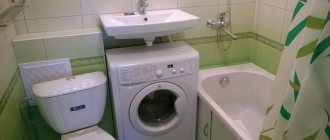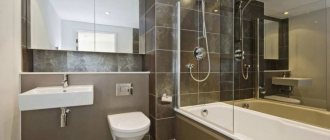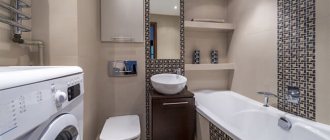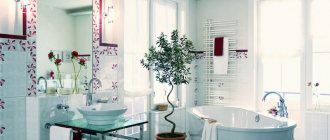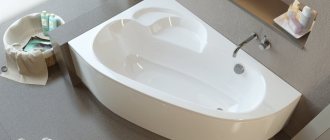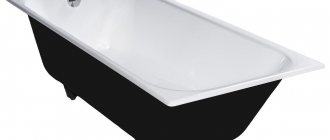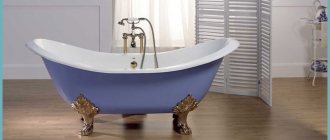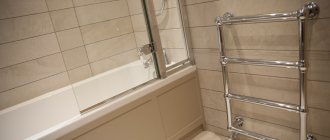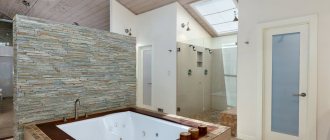What types of bathtubs are there based on the material they are made of?
Cast iron baths - the choice of conservatives
For a long time this type of bathtub had only one competitor and often won the battle, but even today, despite the appearance of worthy opponents, it does not lose its position. And this despite the fact that this type does not differ in variety of shapes; only oval and rectangular ones are presented on the market.
But they are reliable, durable, have low thermal conductivity, and the water temperature in them drops by 5-10°C per hour, which makes taking a bath in them a fairly comfortable process. But in terms of this indicator, their leadership is second only to ceramic bathtubs. Among the positive characteristics of cast iron bathtubs, consumers highlight their “no noise”, that is, the process of drawing water is quite quiet, unlike steel ones, as well as internal strength
But, the weight of this bathtub is quite large, depending on the size, ranging from 100 to 150 kg, which significantly complicates its transportation and installation. You should select the right cleaning compounds, avoid the use of abrasives, but most importantly, when purchasing, pay attention to the quality of the enamel coating. It must be free of any smudges, roughness, and even more so, chips. If chips or scratches appear during operation, then restoring the integrity of the coating, although difficult, is possible.
It should be noted that in modern cast iron bathtubs, instead of enamel, a more elastic polymer coating is used, their shape has become more ergonomic, and the price is one of the most affordable among other products from a similar group of products.
Steel baths - a reasonable compromise
Having been an alternative to cast iron bathtubs for a long time, steel bathtubs are, out of habit, compared with them, although, in terms of performance characteristics, they are closer to acrylic ones. They have a low weight, in the range of 30-40 kg, a decent service life, reaching 25-30 years, and a low price. They have high thermal conductivity and “noisiness”.
True, these shortcomings can be corrected by proper installation: you should use the principle of a closed space under the bathtub, which is additionally filled with polystyrene foam, mineral wool, or blown with polyurethane foam. In addition, due to its light weight, care should be taken to ensure that the bathtub is securely fastened.
Modern steel bathtubs have not only the traditional rectangular shape; for the bathroom you can choose products with round, corner, or oval shapes. In addition, they can be equipped with additional options that increase the comfort of their use: handrails, armrests and even hydromassage. Modern steel bathtubs can be coated with enamel (less and less often) or polymer coatings.
Acrylic bathtub – the choice of an energetic person
After appearing on the market, acrylic bathtubs quickly began to gain popularity due to their optimal price, high performance characteristics, variety of shapes, sizes, and color variety. All types of acrylic bathtubs are light in weight, only 15-20 kg, their installation is not particularly difficult, but in order for the product to last for 7-15 years under warranty, it must be chosen correctly and subsequently follow some operating rules.
Acrylic bathtubs are manufactured using two technologies:
- the first option - a “shell” made of acrylic polymer is poured onto a fiberglass frame, acting as a reinforcing frame;
- the second option involves the use of two-layer extruded sheet material.
The positive characteristics of these bathtubs significantly outweigh the negative ones, which helps them maintain their top positions in sales. They have low thermal conductivity, are silent, and have a beautiful aesthetic appearance, which does not require much time to maintain. If scratches or other damage appears, they are amenable to restoration work, which you can do yourself. For example, you can give the original gloss using a special polish for acrylic bathtubs.
But you should carefully select care products, since the surface is sensitive to many types of chemical compounds. It is not allowed to place basins, including plastic ones, in the bathtub, however, for a modern person, the owner of an automatic washing machine, there is no special need for this.
The surface of an acrylic bathtub is very sensitive to high temperatures; you should always remember that acrylic melts at only 160°C, so very hot water temperatures are prohibited, as this will lead to deformation of the product. It should also be noted the high mechanical fragility of the material.
Quaril baths – the choice of the knowledgeable
Quaryl or quaryl bathtubs are made from modern innovative material, a mixture of practical acrylic and durable quartz. This ensures their high performance and aesthetic characteristics. They are impact-resistant, silent, maintain water temperature well, are hygienic, and can have a wide variety of shapes. Due to the presence of quartz sand in the material, they are heavier than acrylic, but much lighter than cast iron. However, the acrylic component does not allow high-temperature water to be poured into it, since even such a fairly massive structure can be deformed.
Quaril baths are made by casting, the shape for which can be very diverse in both type and size, including depth. And given that the average wall thickness is about 1 cm, you don’t have to use a frame during installation. The main color scheme is pastel colors, but there are exceptions, for example, bathtubs in black, burgundy, green and others.
The main distinguishing feature of quaril baths, in addition to their appearance and characteristics, is functionality. In many models, in addition to built-in hydromassage, aeromassage, armrests and headrests, a radio or other high-tech options can be built-in.
Caring for such bathtubs is quite simple and boils down to regular rinsing and periodic treatment with disinfectants, but without abrasives in their composition. Owners of acrylic bathtubs should be very careful with dyes, which stain the surface and are practically impossible to remove.
Ceramic, stone baths - the choice of aesthetes
The material from which ceramic baths are made guarantees a good ability to retain heat, noiselessness, such products naturally do not rust, are not subject to mechanical damage, are durable, but they are distinguished by a high price, heavy weight, fragility, transportation and installation should be carried out especially carefully. Therefore, these are, most often, exclusive products that can be made to order for a specific interior.
Both natural stone, such as marble, and artificial stone can be used to make bathtubs. Products made from the latter are a type of ceramic bathtub and have similar performance characteristics.
The artificial stone that is used for the production of bathtubs has a composition of clay and various types of stone chips from quartz and/or granite, as well as dyes that help give almost any color to the product. The texture of the material is very similar to natural, but much lighter in weight.
Products made from artificial stone also belong to the exclusive class, and their cost is very high. Therefore, they are installed in the interiors of bathrooms of country cottages, for the interiors of which designers specially developed original designs.
Acrylic bathtubs
Bathtubs made of acrylic, in our opinion, combine the optimal ratio of price and performance characteristics. The weight of the product is 12-18 kg, so transportation and installation can be carried out independently. The high strength of the polymer ensures a good service life (more than 7 years), however, there are some limitations during operation. Do not place heavy metal objects (for example, buckets of water) in the bathtub, or pour boiling water. All this can damage her.
The polymer has excellent thermal insulation, so the water in such a bath will cool for a very long time. In addition, it makes almost no noise from falling drops. The technology for producing acrylic bathtubs allows us to produce products of any shape and configuration: rectangular, round, trapezoidal, etc. Some manufacturers can make a custom-made bathtub according to a given sketch.
Photo 3. Acrylic bathtub
Over time, micro-scratches appear on the internal glossy surface, in which dirt accumulates, resulting in the appearance of the product deteriorating. In order to give the acrylic bathtub its original appearance, it is enough to sand the surface with 1000-1500 grit sandpaper. It is best to use waterproof sandpaper, and be sure to work on a well-wet surface. After this, treat the surface with abrasive polish, and the bathroom will be like new! The wall thickness is usually at least 4-5 mm, so you can give the product its original appearance many times without the risk of damaging it.
Bathtub shapes and sizes
Modern bathtubs are made from a variety of materials, many of which allow the product to be shaped into a wide variety of shapes. Therefore, determining which types of bathtubs will be better for a particular room will not be difficult. This factor allows not only to make the bathroom more aesthetically attractive, but also to rationally use the space, which is often very limited.
Rectangular or traditional bathtubs
Bathtubs of this shape are available in all possible materials. In addition to bathtubs of standard sizes 180x80 cm, the market offers models with dimensions ranging from 120x70/75/80 cm, the so-called “sitting” ones, to full-size 120/150/160/170/180x70-75/80.
Corner baths - helpers in optimizing space
Despite the apparent bulkiness and non-standard shape, it is corner baths that help to more rationally use and organize the space of the bathroom, especially of modest sizes.
But, when purchasing, you should definitely pay attention to the fact that they come in:
- "right" and "left";
- symmetrical and asymmetrical.
Corner symmetrical bathtub.
Corner asymmetrical bathtub.
They are mainly made from acrylic or steel, but on request they can also be made from artificial stone. There are also models made of artificial stone among them. They are often equipped with hydromassage and other options. For bathrooms with sufficient space, it is very convenient to combine them with a shower stall.
The size range of corner baths is quite wide and mainly depends on the symmetry of the shape, ranging from:
- 120×120 cm to 180×180 cm – for symmetrical models;
- 120×60 cm to 190×170 cm – for asymmetrical models.
Oval bathtubs - laconic style of shapes
They are made from almost all basic materials for bathtubs, they are distinguished by their laconic and soft forms, which allows you to create an interior that is most conducive to relaxation and relaxation. Especially for this purpose, most models of this form are equipped with hydro or air massage. But they usually lack armrests and headrests, as well as special elements for sitting. The size range is varied, but if we talk about standards, they are in the range of 140 – 210 cm.
Round bath - the pursuit of ideal
This is an exclusive form of bathtub. Depending on the size, it can be double or even multi-seater. The round shape of the bathtub is the most convenient for the installation and operation of hydromassage nozzles, therefore, its main purpose is not hygienic procedures, but a device for relaxation.
But, regardless of the size, which can range from 140 to 210 cm in diameter, its installation requires a room with sufficient area, allowing access from all sides. They are mainly made from acrylic, less often steel, but to create exclusive models, quarryl, artificial or natural stone, etc. are used.
In general, when considering different types of bathtubs, their differences, advantages and disadvantages, the choice should be made based on the needs of family members and their preferences, not forgetting that installing a bathtub is a responsible matter, since it will have to be used for at least several years. Elderly people and children require special attention.
For the first, a sitz bath with a depth of 60 to 80 cm may be a comfortable option, while for the second, on the contrary, a shallow but fairly spacious model will be more convenient.
In order for the adoption of water and/or hygienic procedures in the bath to be as comfortable as possible, it must have sufficient dimensions for this, the main ones being length and depth (the minimum standard width is 70-80 cm - optimal for people with a standard build). In order to make the bath deeper, but not more bulky, manufacturers use, for example, a method of creating flatter sides.

